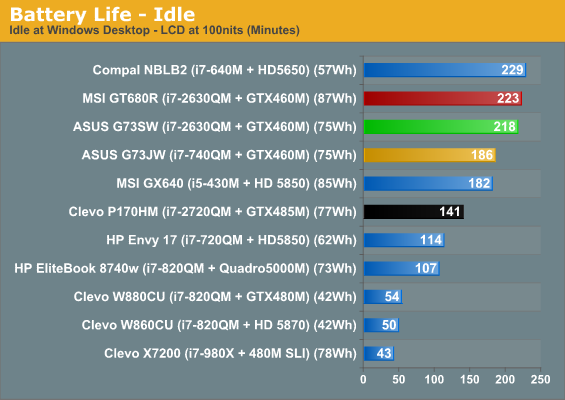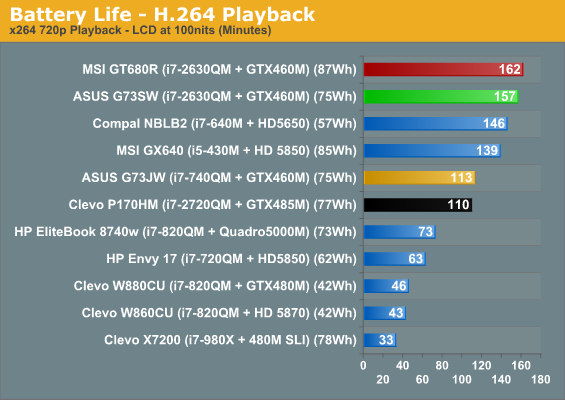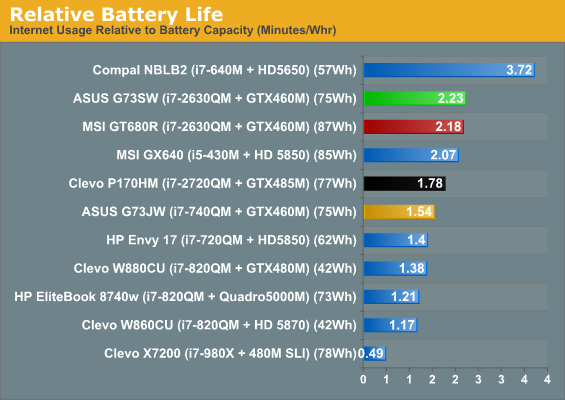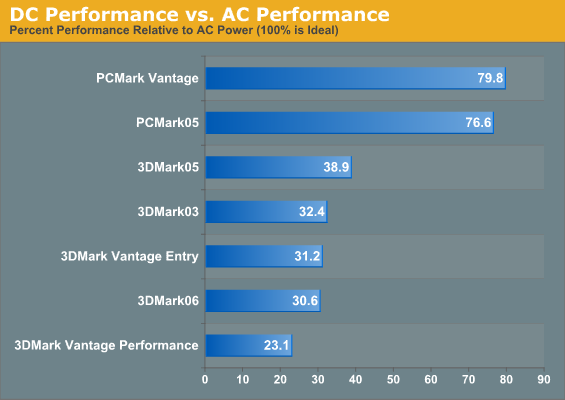ASUS G73SW + SNB: Third Time’s the Charm?
by Jarred Walton on March 4, 2011 12:00 AM ESTBattery Life
The G73 is a 17.3” notebook chassis with a 75Wh battery; we know what that means, right? You’re not going to get all-day computing, or even half a day (unless you have a six-hour workday). We also know that Sandy Bridge is more power efficient than Clarksfield, so we should see some gains relative to the G73JW. And that’s exactly what we get.




Idle battery life is up 17% to 3.75 hours, and that’s the smallest increase. Internet battery life is up 27%, though it falls just shy of the three-hour mark, and H.264 decoding is up 39% to over 2.5 hours. While those are all fairly impressive increases over the previous generation, let’s not lose sight of what we could get with switchable graphics. A vanilla i7-2820QM notebook running off the HD 3000 IGP manages roughly double the runtime in our battery life testing, and that’s with a slightly smaller battery.
We can actually estimate the idle power requirements of the GTX 460M based off of those results, and let me tell ya, it ain’t pretty. Based on the 71Wh battery and the various test results, the Compal SNB notebook we tested used an average of 9.04W at idle, 10.24W in the Internet test, and 16.38W in H.264 playback. In comparison, the G73SW averages 20.64W idle, 26.95W Internet, and 28.66W in H.264 decoding. That means the GTX 460M requires roughly 10W at idle with very low clocks (50MHz core, 270MHz RAM), around 15W with a web browser showing Flash advertisements, and the difference between HD 3000 and GTX 460M in H.264 encoding is back to ~10W. Sadly, these high-power GPUs just aren’t very friendly to battery life, with just the GPU using about as much power as the rest of the notebook combined. Here’s where NVIDIA’s Optimus Technology would have been useful: twice the battery life, the ability to use Intel’s QuickSync technology, and discrete graphics performance when you want it.
Plugged in power numbrs are all higher, as the GPU isn't in "limp mode" and we also ran the LCD at maximum brightness. At idle, we measured 27W at the outlet using a Kill-A-Watt device; taking into account power adapter inefficiency, that figure matches up pretty well with our above calculation. When we put a 100% load on just the CPU (using Cinebench 11.5 SMP), power draw gets as high as 87W. Running through the various 3DMark tests, we saw a maximum "typical gaming" load of 114W, whereas Furmark manages to push the GPU just a little harder and we measured up to 125W. It's also interesting to note that we couldn't get power draw any higher by running Furmark with a CPU loading utility; the CPU load was apparently enough to reduce Furmark performance and so our "worst-case" CPU+GPU load actually dropped to 118W. Again, factoring in power adapter inefficiencies, there's still plenty of headroom on the 150W power brick (unlike the 300W brick in the Clevo X7200 with SLI systems), so you can even play games while charging the battery.
We've had some reader requests for a few other battery life metrics. Charging time on the G73SW (with the system powered up) checked in at 168 minutes; it might recharge slightly faster if the system is off, but with a 150W power brick there should be plenty of extra juice for the charging circuit. If you want to run the LCD at maximum brightness rather than 100 nits (or cd/m2 if you prefer), idle battery life drops to 195 minutes. So the extra 55 nits of brightness requires an additional ~2.5W of power. We also ran our Internet test with Pandora open and streaming music in a separate browser tab; that dropped battery life down to 140 minutes. Finally, what about gaming on battery? With the GPU set for maximum performance, we managed 67 minutes looping 3DMark06, but there’s still a catch.
Even trying our best to achieve maximum gaming performance while on battery power, the GPU is still throttled—and the CPU appears somewhat slower as well. We ran the full Futuremark test suite on battery power, using the High Performance power profile. The following chart shows the percent of performance relative to the same test running off the mains (so a score of 100 would be no change in performance).

The best results are in PCMark, where battery performance is still 80% of plugged-in performance. Move over to graphics tests, and 3DMark05 managed to maintain nearly 40% of AC performance, 03/05/Vantage Entry are in the range of 30-32% of AC performance, and the Vantage Performance preset is less than one fourth as fast. To put that in perspective, you’re looking at gaming performance that’s actually worse than what you’d get with a midrange GT 425M GPU.
The problem appears to be getting sufficient power to the GPU from the battery for the higher clocks, as the midrange GPUs don’t forcibly throttle performance on battery power (at least in my experience). Then again, it’s not like you get significantly better battery life for gaming on a midrange GPU—I measured 104 minutes with a GT 425M on an 84Wh battery with an i3-380M CPU and a 14” chassis. In other words, while it’s possible to have a gaming laptop that gets good battery life (i.e. by shutting off the GPU), unless something changes in a big way we’re not going to get great gaming performance while on battery power. So fire up your smartphone and play some Angry Birds instead :)










56 Comments
View All Comments
Frallan - Friday, March 4, 2011 - link
I bought an old ASUS gaming lappy with turbo and the 6800GT in it it has served for a long time now and has been demoted to girlfriend computer now. So Im in the market for a new gaming lappy. BUT when spending that much money I want to have decent performance.Therefore I will wait until there is a good sandy brige / GPU combo is out there. Id like it to come from ASUS bc of the good experience Ive had with the old Lappy but if this is what they will have then they\re out of the game.
BR
/F
jcandle - Friday, March 4, 2011 - link
"Contenders like the MSI GT680R (going for $1475 online) offer nearly identical specs"Hey Jarred, how is that a contender? The MSI is a 15 and the Asus is a 17. I have no idea why but bigger in gaming notebooks generally translates to more expensive. Perhaps manufacturers are betting gamers place value on tonnage.
JarredWalton - Friday, March 4, 2011 - link
It's a gaming notebook, therefore it's a contender. The ASUS G53SW is also in the rink, along with Clevo P150HM and P170HM. I'm also a bit surprised that there are essentially equivalent spec notebooks that are smaller and cost less; that's usually not the case. Perhaps the high contrast HannStar LCD is adding more to the total than I think?jcandle - Friday, March 4, 2011 - link
That's exactly my point. Its not an apples to apples comparison because Asus does have the G53SW that essentially the same machine with 1 less HDD with a much lower price point resolving the pricing issue you were so lamenting. You can't compare a 17" machine and says its more expensive than a 15" when similar offering from companies like Dell with Alienware are doing exactly the same thing.JarredWalton - Friday, March 4, 2011 - link
The MSI still supports two HDDs, though, which means the only difference is the overall design elements and the LCD size. The LCD should be a wash, really (both are 1080p, so maybe $25-$50 difference at most). ASUS has the keyboard backlighting and better thermals. Do those three items add up to a nearly $300 price difference? I don't think so.If you go with the ASUS G53SW-XR1 and compare that to the MSI, you still have to factor in the single HDD. I'm also a bit concerned that ASUS might be selling some B2 stepping chipsets with a single HDD, but I don't know for sure if that's the case. Will the Cougar Point bug affect the DVDR or eSATA down the line, or if you add a second HDD/SSD will that be a problem? Hopefully I'm wrong and they're not selling any B2 chipsets in the G53/73 chassis.
Anyway, I've edited the text slightly to clarify that I'm looking at all similar performance gaming notebooks, not necessarily just "all 17.3-inch heavyweight contenders". :-)
jcandle - Friday, March 4, 2011 - link
Don't get me wrong I'm backing you up on the point that "essentially equivalent spec notebooks that are smaller and cost less" Maybe there should be some investigating to find out why manufacturers are simply bumping up the form factor and asking for a non-proportional $300 price difference.mattwco - Saturday, March 5, 2011 - link
When stock levels come back, there's an -XR1 variant that has one HDD and a DVD-RW for $1400. It may have a lesser warranty as well.If you're comparing the G73SW to other laptops, please note that there's more than one G73SW. BTW, the 3D version is also coming back in stock at ~$1900.
mattwco - Saturday, March 5, 2011 - link
Jarred mentioned the XR1 version above. Several other variants are available at different price points. The -B3 has a better warranty than the -A1.Example, not company recommendation:
http://pro-star.com/index.cfm?mainpage=product&...
Also, the laptops with the fixed chipset are explicitly labeled so on the laptop and on the box.
http://www.asus.com/News.aspx?N_ID=Bdmf9rXuqU29SRs...
piroroadkill - Friday, March 4, 2011 - link
8GB is thoroughly pointless, as is a quad core.I'd much rather have a higher clocked dual core for gaming... 4GB RAM is just fine..
... and mechanical disks? One SSD, one Mechanical disk is the correct way.
piroroadkill - Friday, March 4, 2011 - link
I should note, on my dual/quad comment, I meant that a higher clocked dual core would be a better tradeoff for performance/power use in the vast majority of games. Obviously a high clocked quad is the best of all worlds.